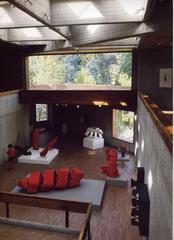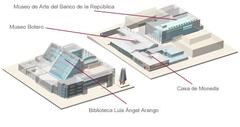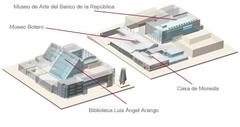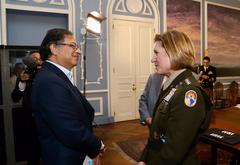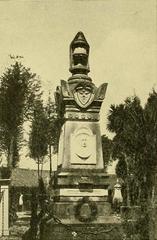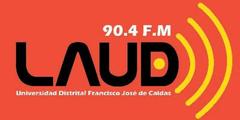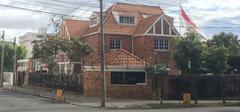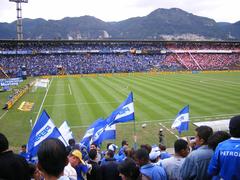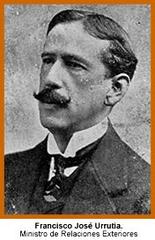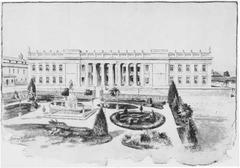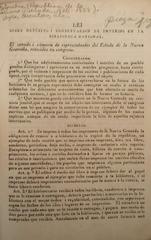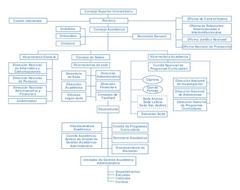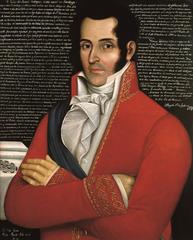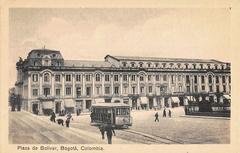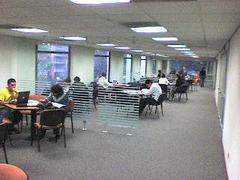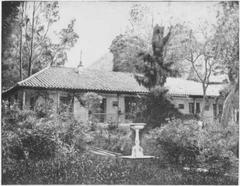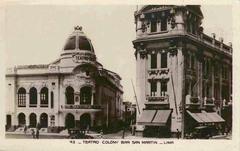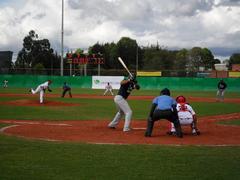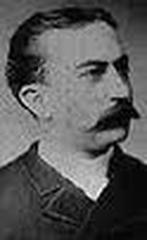
Museum of Colonial Art Bogotá: Visiting Hours, Tickets, and Visitor Guide
Date: 04/07/2025
Introduction
Nestled in the heart of Bogotá’s historic La Candelaria district, the Museum of Colonial Art (Museo de Arte Colonial) offers an immersive journey into Colombia’s colonial past. Housed in the beautifully preserved 17th-century Las Aulas Cloister—a former Jesuit college recognized as a national monument—the museum showcases an extensive collection of religious and secular art, decorative objects, and historical artifacts. Since its founding in 1942, the museum has grown into a pivotal cultural institution, preserving, studying, and interpreting the artistic and social legacies of the colonial period. This comprehensive guide details everything you need to plan your visit, from opening hours and ticket prices to collection highlights, accessibility, and nearby attractions (Frommer’s, Museo Colonial official site, Lonely Planet).
Contents
- Historical Background and Museum Evolution
- Visiting the Museum: Hours, Tickets, Accessibility
- Collection Highlights and Exhibition Approach
- Guided Tours, Educational Programs, and Events
- Practical Travel Tips and Nearby Attractions
- Frequently Asked Questions (FAQ)
- Visuals and Media
- References
Historical Background and Museum Evolution
Origins and Colonial Context
The museum is housed in the Las Aulas Cloister, one of Bogotá’s oldest surviving buildings. This structure, built by the Jesuits in the early 1600s, served as both a college and a religious center. The building itself is an architectural treasure, featuring thick adobe walls, internal courtyards, and wooden balconies that reflect the Spanish colonial style. Its preservation as a national monument offers visitors a tangible connection to Bogotá’s colonial era (Frommer’s, Lonely Planet).
Founding and Museum Development
Established in 1942, the Museo de Arte Colonial was created to protect and interpret Colombia’s colonial artistic and cultural heritage. Early collections were sourced from ecclesiastical holdings, private donations, and state acquisitions, centering on religious art, furniture, and everyday objects from the 17th and 18th centuries. Over time, the museum expanded its scope, integrating a wider array of artifacts and increasing its focus on contextual and critical interpretations of colonial history (Frommer’s).
Renovations and Modernization
Between 2014 and 2017, the museum underwent extensive renovations to restore the historic cloister, improve conservation facilities, and modernize exhibition spaces. The revitalized galleries now offer thematic and chronological displays, integrating multimedia resources and bilingual interpretation to enhance accessibility for both local and international visitors (Lonely Planet).
Visiting the Museum: Hours, Tickets, Accessibility
Opening Hours
- Tuesday to Saturday: 9:00 AM – 5:00 PM
- Sunday: 10:00 AM – 4:00 PM
- Closed on Mondays and public holidays
Always check the official website for updates, especially around holidays.
Tickets and Admission
- General Admission: COP 10,000 (approx. USD 3)
- Discounted Tickets: Students, seniors, and children receive reduced rates
- Children under 12: Often free of charge
- How to Buy: At the entrance or online via the official website
Accessibility
Recent renovations have improved accessibility, with ramps and elevators in key areas. Some historic sections may remain challenging due to stairs and uneven floors. Visitors with mobility needs should contact the museum in advance for assistance.
Facilities
- Restrooms: Available on site
- Gift Shop: Small selection of souvenirs
- Café: Light refreshments available
- Seating: Benches in some galleries and the courtyard
Collection Highlights and Exhibition Approach
Collection Origins and Scope
The museum’s collection traces its roots to private donations and ecclesiastical assets transferred during the 19th century, particularly following expropriation policies in the 1860s. Today, it houses nearly 2,000 pieces spanning the 16th to 18th centuries, making it one of Colombia’s premier repositories of colonial art (academia-lab.com).
Notable Categories
- Religious Art:
- Altarpieces and Retablos: Ornate, gilded wood structures
- Polychrome Sculptures: Used in processions and rituals
- Paintings: Works by Gregorio Vásquez de Arce y Ceballos, including the celebrated “Virgen de la Leche”
- Cuzco School Paintings: Vivid, syncretic works blending European and Andean traditions
- Decorative Arts:
- Furniture: Chests, tables, and cabinets, often inlaid and carved
- Silverwork: Chalices, monstrances, and liturgical objects
- Textiles: Embroidered vestments and altar cloths
- Secular Art and Portraiture: Oil portraits of colonial elites, urban scenes, and genre paintings
- Archival Materials: Manuscripts, religious texts, and personal correspondence
Curation Philosophy
The museum’s curatorial approach emphasizes thematic organization and narrative storytelling, exploring topics such as religious devotion, social hierarchies, and the complexities of colonial identity. The 2017 renovation introduced interactive displays, improved lighting, and bilingual labels, making the museum’s history and collections accessible to a diverse audience (academia-lab.com).
Historic Setting
The museum is set within the “Casa de las Aulas,” a colonial-era cloister with arcaded courtyards and wooden ceilings. The chapel, notable for historic events such as the first performance of Colombia’s national anthem, now houses key religious works (academia-lab.com).
Guided Tours, Educational Programs, and Events
- Guided Tours: Available in Spanish and English; inquire at the reception or book in advance
- Workshops and Lectures: Regularly scheduled for students, families, and scholars
- Temporary Exhibitions: Rotating displays highlight contemporary themes and new research
- Digital Resources: Virtual tours and scholarly articles are accessible on the museum website (GPSmyCity)
Practical Travel Tips and Nearby Attractions
Getting There
- Address: Carrera 6 No. 9-77, La Candelaria, Bogotá
- Transport: Easily accessible by foot, taxi, or public transit; nearby TransMilenio stations and bus lines
Travel Tips
- Best Time to Visit: Weekday mornings for fewer crowds
- Language: Most signage is in Spanish; basic Spanish or a translation app is helpful (Xixerone)
- Weather: Bogotá’s climate is variable—bring layers and an umbrella (Xixerone)
- Safety: La Candelaria is generally safe by day; exercise standard precautions (Xixerone)
- Photography: Allowed without flash in most galleries; check for restrictions
Nearby Attractions
- Gold Museum (Museo del Oro): Pre-Columbian gold artifacts
- Plaza Bolívar: Bogotá’s main square with historic buildings
- Botero Museum: Artworks by Fernando Botero and international artists
- Santa Clara Church Museum: Baroque art and architecture
Frequently Asked Questions (FAQ)
Q: What are the Museum of Colonial Art Bogotá visiting hours?
A: Tuesday to Saturday, 9:00 AM – 5:00 PM; Sunday, 10:00 AM – 4:00 PM; closed Mondays and public holidays.
Q: How much are tickets?
A: General admission is COP 10,000 (~USD 3), with discounts for students, seniors, and children.
Q: Can I buy tickets online?
A: Yes, via the official website or at the entrance.
Q: Is the museum accessible for visitors with disabilities?
A: Yes, with ramps and elevators in most areas; contact in advance for specific needs.
Q: Are guided tours available?
A: Yes, in Spanish and English; inquire at the desk or book online.
Q: Can I take photographs?
A: Yes, without flash in most areas. Always confirm with staff.
Q: What other sites are nearby?
A: The Gold Museum, Plaza Bolívar, Botero Museum, and Santa Clara Church Museum are all within walking distance.
Visuals and Media
Consider including high-quality images with descriptive alt tags, such as:
- “Exterior view of Museo de Arte Colonial Bogotá”
- “Colonial paintings inside Museo de Arte Colonial”
- “Las Aulas Cloister courtyard in Bogotá”
Virtual tours and multimedia guides are available on the official museum website.
References
- Frommer’s: Museo de Arte Colonial
- Museo Colonial official site
- Lonely Planet: Museo de Arte Colonial Bogotá
- academia-lab.com: Museum of Colonial Art of Bogotá
- WhichMuseum: Colonial Art Museum of Bogotá
- Over Your Place: Bogotá Culture, Traditions & Festivals
- Visit Bogotá: Colonial Museum
- GPSmyCity: Museo de Arte Colonial
- Xixerone: Mistakes to Avoid in Bogotá
Conclusion
The Museum of Colonial Art Bogotá is not only a custodian of Colombia’s colonial legacy but also a vibrant cultural destination that fosters critical reflection and appreciation of the country’s complex history. Its central location, accessible facilities, and engaging exhibitions make it a must-visit for history buffs, art lovers, and curious travelers alike. Enhance your Bogotá experience by exploring this extraordinary museum, and consider combining your visit with nearby historical sites for a comprehensive cultural journey. For guided tours and audio content, download the Audiala app and stay informed on museum events and updates.







